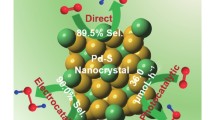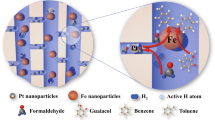Abstract
While the enzymatic reduction of unsaturated compounds usually has high specificity, highly selective reduction processes are hardly realized by heterogeneous industrial catalysts, which is critical for the green production of many fine chemicals. Here, we report an unexpected discovery of a biomimetic behavior of dicyandiamide (DICY)-modified Pt nanocatalysts for the green hydrogenation of a wide range of nitroaromatics. We demonstrate that the surface modification by DICY not only prevents the direct contact of nitroaromatic reactants with Pt surface but also induces an effective non-contact hydrogenation mechanism mediated by protons and electrons. In such a process, the DICY layer serves as a “semi-permeable membrane” to allow the permeation of H2 molecules for being activated into electrons and protons at the Pt-DICY interface. With the generation of separated protons and electrons, the nitro group with strong electrophilic properties can be hydrogenated through the electron transfer followed by the proton transfer, which is facilitated by the hydrogen bonding network formed by protonated DICY. The unique mechanism makes it highly directional toward the hydrogenation of nitro groups without side reactions. Owing to its capability to largely eliminate the waste generation, the developed Pt-DICY catalysts have been successfully applied for the green industrial production of many important aniline intermediates.

Similar content being viewed by others
References
Graciani J, Mudiyanselage K, Xu F, Baber AE, Evans J, Senanayake SD, Stacchiola DJ, Liu P, Hrbek J, Fernández Sanz J, Rodriguez JA. Science, 2014, 345: 546–550
Kyriakou G, Boucher MB, Jewell AD, Lewis EA, Lawton TJ, Baber AE, Tierney HL, Flytzani-Stephanopoulos M, Sykes ECH. Science, 2012, 335: 1209–1212
Corma A, Serna P. Science, 2006, 313: 332–334
Chai Y, Wu G, Liu X, Ren Y, Dai W, Wang C, Xie Z, Guan N, Li L. J Am Chem Soc, 2019, 141: 9920–9927
Aich P, Wei H, Basan B, Kropf AJ, Schweitzer NM, Marshall CL, Miller JT, Meyer R. J Phys Chem C, 2015, 119: 18140–18148
Fiorio JL, López N, Rossi LM. ACS Catal, 2017, 7: 2973–2980
García-Melchor M, López N. J Phys Chem C, 2014, 118: 10921–10926
Sellmann D, Prakash R, Heinemann FW, Moll M, Klimowicz M. Angew Chem Int Ed, 2004, 43: 1877–1880
Taylor MJ, Durndell LJ, Isaacs MA, Parlett CMA, Wilson K, Lee AF, Kyriakou G. Appl Catal B-Environ, 2016, 180: 580–585
Marshall ST, O’Brien M, Oetter B, Corpuz A, Richards RM, Schwartz DK, Medlin JW. Nat Mater, 2010, 9: 853–858
Makosch M, Lin WI, Bumbálek V, Sá J, Medlin JW, Hungerbühler K, van Bokhoven JA. ACS Catal, 2012, 2: 2079–2081
Albani D, Vilé G, Mitchell S, Witte PT, Almora-Barrios N, Verel R, López N, Pérez-Ramírez J. Catal Sci Technol, 2016, 6: 1621–1631
Kuchenreuther JM, Guo Y, Wang H, Myers WK, George SJ, Boyke CA, Yoda Y, Alp EE, Zhao J, Britt RD, Swartz JR, Cramer SP. Biochemistry, 2013, 52: 818–826
Vincent KA, Li X, Blanford CF, Belsey NA, Weiner JH, Armstrong FA. Nat Chem Biol, 2007, 3: 761–762
Frey M. ChemBioChem, 2002, 3: 153–160
Schilter D, Camara JM, Huynh MT, Hammes-Schiffer S, Rauchfuss TB. Chem Rev, 2016, 116: 8693–8749
Tai H, Hirota S, Stripp ST. Acc Chem Res, 2021, 54: 232–241
Peters JW, Schut GJ, Boyd ES, Mulder DW, Shepard EM, Broderick JB, King PW, Adams MWW. BioChim Biophys Acta (BBA) — Mol Cell Res, 2015, 1853: 1350–1369
Huang G, Wagner T, Ermler U, Shima S. Nat Rev Chem, 2020, 4: 213–221
Slocik JM, Govorov AO, Naik RR. Angew Chem Int Ed, 2008, 47: 5335–5339
Meeuwissen J, Reek JNH. Nat Chem, 2010, 2: 615–621
Manea F, Houillon FB, Pasquato L, Scrimin P. Angew Chem Int Ed, 2004, 43: 6165–6169
Reback ML, Ginovska-Pangovska B, Ho MH, Jain A, Squier TC, Raugei S, Roberts JAS, Shaw WJ. Chem Eur J, 2013, 19: 1928–1941
Simmons TR, Berggren G, Bacchi M, Fontecave M, Artero V. Coord Chem Rev, 2014, 270–271: 127–150
Zaffaroni R, Detz RJ, van der Vlugt JI, Reek JNH. ChemSusChem, 2018, 11: 209–218
Hannink N, Rosser SJ, French CE, Basran A, Murray JAH, Nicklin S, Bruce NC. Nat Biotechnol, 2001, 19: 1168–1172
Race PR, Lovering AL, Green RM, Ossor A, White SA, Searle PF, Wrighton CJ, Hyde EI. J Biol Chem, 2005, 280: 13256–13264
Lovering AL, Hyde EI, Searle PF, White SA. J Mol Biol, 2001, 309: 203–213
Chen G, Tan Y, Wu B, Fu G, Zheng N. Chem Commun, 2012, 48: 2758–2760
Sexton BA, Avery NR. Surf Sci, 1983, 129: 21–36
Shayeghi A, Krähling S, Hörtz P, Johnston RL, Heard CJ, Schäfer R. J Phys Chem C, 2017, 121: 21354–21363
Adamczyk AJ. Surf Sci, 2019, 682: 84–98
Kahsar KR, Schwartz DK, Medlin JW. J Am Chem Soc, 2014, 136: 520–526
Vilé G, Almora-Barrios N, López N, Pérez-Ramírez J. ACS Catal, 2015, 5: 3767–3778
Xu KX, Guo MH, Ren LQ, Huang W, Sun JJ. Sci China Chem, 2018, 61: 360–367
Collado JA, Ramírez FJ. J Raman Spectrosc, 1999, 30: 391–397
Yezhelyev MV, Qi L, O’Regan RM, Nie S, Gao X. J Am Chem Soc, 2008, 130: 9006–9012
Belding L, Stoyanov P, Dudding T. J Org Chem, 2016, 81: 553–558
Bai J, Zhou Y, Chen Q, Yang Q, Yang J. ChemBioChem, 2015, 16: 1219–1225
Haynes CA, Koder RL, Miller AF, Rodgers DW. J Biol Chem, 2002, 277: 11513–11520
Hecht HJ, Erdmann H, Park HJ, Sprinzl M, Schmid RD. Nat Struct Mol Biol, 1995, 2: 1109–1114
Chalkley MJ, Garrido-Barros P, Peters JC. Science, 2020, 369: 850–854
Acknowledgements
This work was supported by the National Key Research and Development Program of China (2017YFA0207302) and the National Nature Science Foundation of China (21890752, 21731005, 22072116, 92045303). N.F. Zheng acknowledges support from the Tencent Foundation through the XPLORER PRIZE. We also thank the XAFS Station (BL14W1) of the Shanghai Synchrotron Radiation Facility (SSRF).
Author information
Authors and Affiliations
Corresponding authors
Ethics declarations
Conflict of interest The authors declare no conflict of interest.
Additional information
Supporting information The supporting information is available online at http://chem.scichina.com and http://link.springer.com/journal/11426. The supporting materials are published as submitted, without typesetting or editing. The responsibility for scientific accuracy and content remains entirely with the authors.
Electronic supplementary material
Rights and permissions
About this article
Cite this article
Zhou, W., Li, L., Qin, R. et al. Non-contact biomimetic mechanism for selective hydrogenation of nitroaromatics on heterogeneous metal nanocatalysts. Sci. China Chem. 65, 726–732 (2022). https://doi.org/10.1007/s11426-021-1198-2
Received:
Accepted:
Published:
Issue Date:
DOI: https://doi.org/10.1007/s11426-021-1198-2




